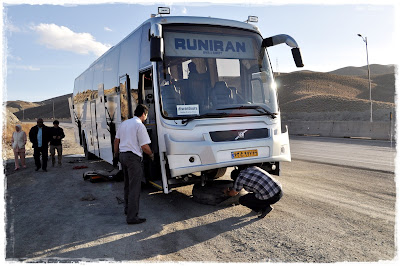"Hope is like the sun, which as we journey toward it, casts the shadow of our burden behind us..." - Samuel Smiles
 |
| (Rostam, the mythical hero of the Shahnameh) |
Day 06: Saturday, 12 Mar 2016
Route: Shiraz – Isfahan
Distance: 485 km
Hotel: Piroozi Hotel, Isfahan
Today we travelled by bus from Shiraz to Isfahan. We visited a few more historical sites before leaving Shiraz.
Eram Garden, Shiraz
The Eram Garden is a historic Persian garden in Shiraz. The garden, and the building within it, are located at the northern shore of the Khoshk River in the Fars province.
 |
| (The entrance to Eram Garden) |
 |
| (Famous calligraphies and poems written on the pliths of the mansion) |
 |
| (The mansion and surrounding garden) |
 |
| (The prominent two storey central porch of the mansion) |
Both the building and the garden were built during the middle of thirteenth century by the Ilkhanate or a paramount chief of the Qashqai tribes of Pars. The original layout of the garden however, with its quadripartite Persian Paradise garden structure was most likely laid in eleventh century by the Seljuqs, and was then referred to as the The King's Garden and was much less complicated or ornamental. The structure housed 32 rooms on two stories, decorated by tiles with poems from the poet Hafez written on them.
Today, Eram Garden and building are within Shiraz Botanical Garden of Shiraz University. They are open to the public as a historic landscape garden. They are World Heritage Site, and protected by Iran's Cultural Heritage Organization.
 |
| (Beautiful flowers, beginning of spring) |
 |
| (Figurines at the souvenir shop) |
Naqsh-e-Rostam, Shiraz
The Naqsh-e Rostam is an ancient necropolis located about 12 km northwest of Persepolis, in Fars Province, with the best group of ancient rock reliefs in Iran cut into the cliff, from both the Achaemenid and Sassanid periods. It lies a few hundred meters from Naqsh-e Rajab, with a further group of Sassanid reliefs.
 |
| (Spectacular ancient sites of the Achaemenid Empire) |
 |
| (Ancient tombs for powerful Persian kings) |
The oldest relief at Naqsh-i Rostam dates to 1000 BC. Though it is severely damaged, it depicts a faint image of a man with unusual head-gear and is thought to be Elamite in origin. The depiction is part of a larger mural, most of which was removed at the command of Bahram II. The man with the unusual cap gives the site its name, Naqsh-e Rostam, ‘Rostam Inscription’, because the relief was locally believed to be a depiction of the mythical hero Rostam.
 |
| (The rock-cut tombs of rulers and their families) |
 |
| (Decorated reliefs carved by the Sasanians) |
 |
| (The burial chambers carved into the side of the hill) |
 |
| (A royal necropolis, a ceremonial center) |
Four tombs belonging to Achaemenid kings are carved out of the rock face at a considerable height above the ground. The tombs are known locally as the 'Persian crosses', after the shape of the facades of the tombs. The entrance to each tomb is at the center of each cross, which opens onto to a small chamber, where the king lay in a sarcophagus. The horizontal beam of each of the tomb's facades is believed to be a replica of the entrance of the palace at Persepolis.
 |
| (Souvenirs depicting Iranian ladies) |
 |
| (A popular souvenir from Acropolis) |
 |
| (Ancient calligraphy) |
Tomb of Cyrus Pasargadae, Shiraz
Pasargadae was the capital of the Achaemenid Empire under Cyrus the Great who had issued its construction, it was also the location of his tomb. It was a city in ancient Persia, located near the city of Shiraz, and is today an archaeological site and one of Iran's UNESCO World Heritage Sites.
Cyrus the Great began building the capital but it was unfinished when he died in battle. The remains of the tomb of Cyrus' son and successor Cambyses II have been found in Pasargadae, near the fortress of Toll-e Takht. The archaeological site includes a structure believed to be the mausoleum of Cyrus, the fortress of Toll-e Takht sitting on top of a nearby hill, and the remains of two royal palaces and gardens.
The most important monument in Pasargadae is the tomb of Cyrus the Great. It has six broad steps leading to the sepulchre, the chamber has a low and narrow entrance.
 |
| (The ancient tomb of Cyrus the Great) |
 |
| (The burial building sits atop of stacked platforms) |
 |
| (Signage to other related historical sites) |
After visiting the historical sites, we traveled on the main highway to Isfahan. On the way, one of the bus experienced a punctured tyre. We arrived at the hotel in Isfahan very late. After checking-in, we had buffet dinner and retired for the night.
 |
| (The driver and son, hard at work) |
 |
| (Equipped with all the necessary tools) |
 |
| (A deserted highway far away from civilisation) |
 |
| (Playing with shadows in the desert) |
 |
| (Arriving at the hotel late at night) |

























No comments:
Post a Comment